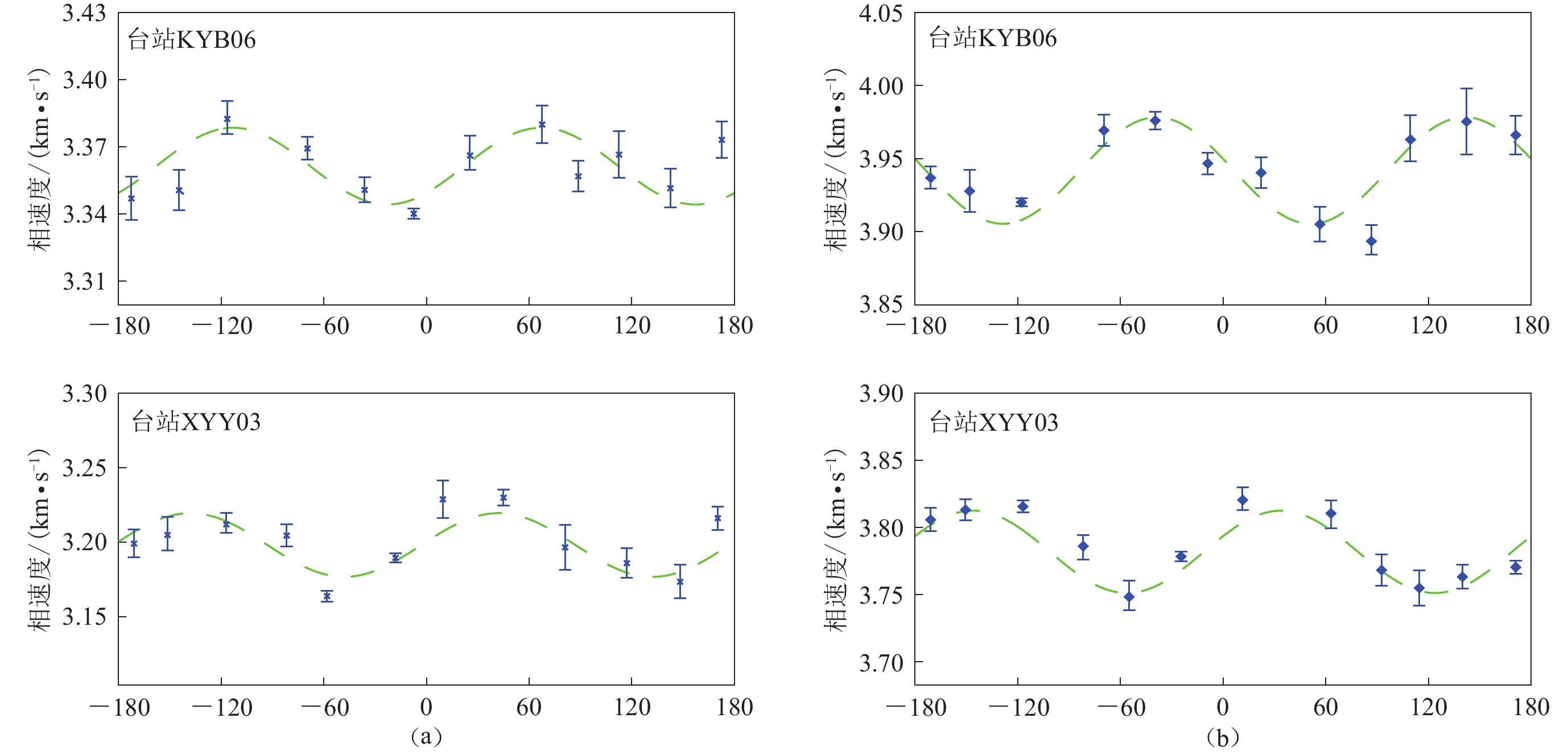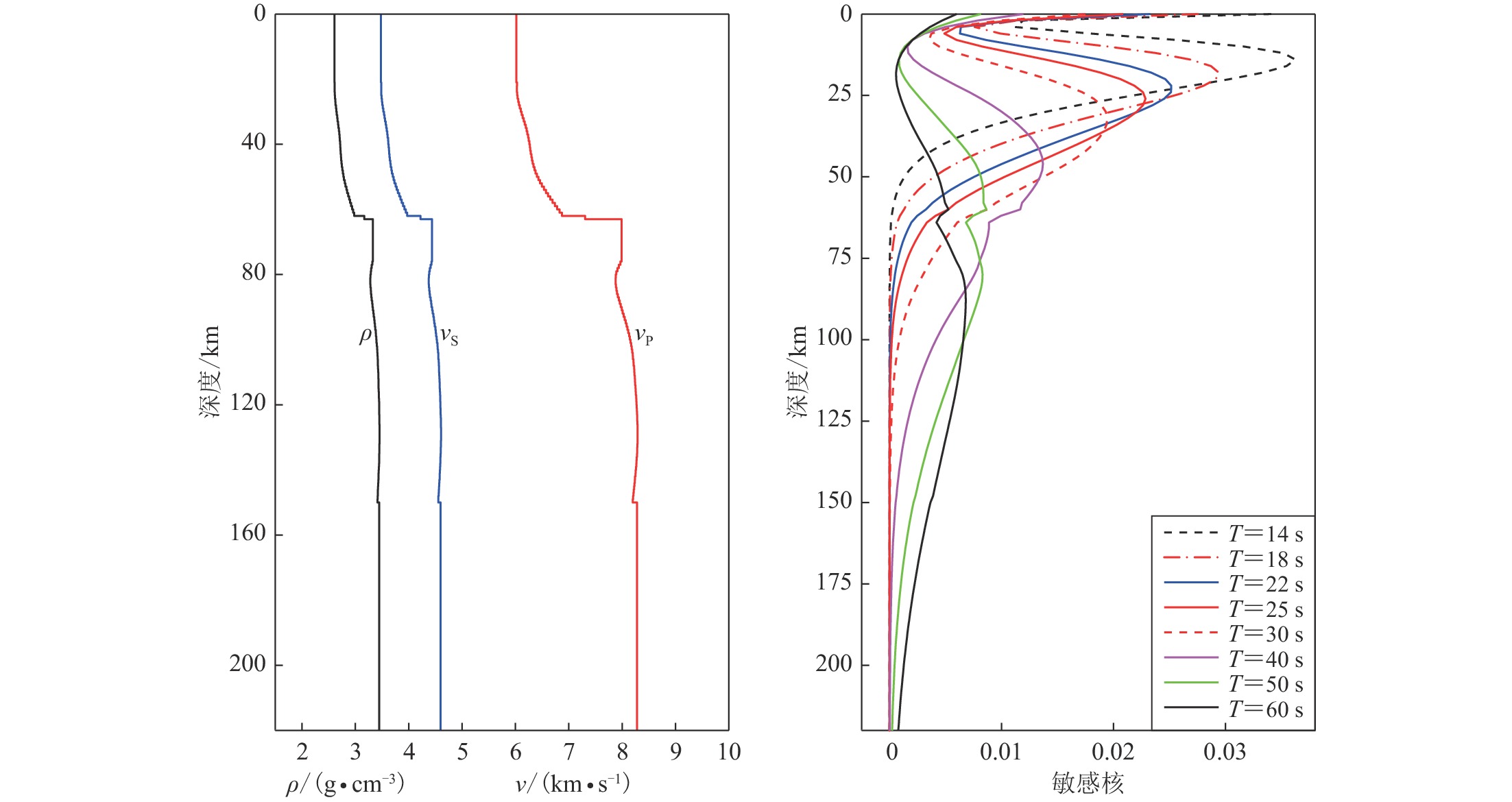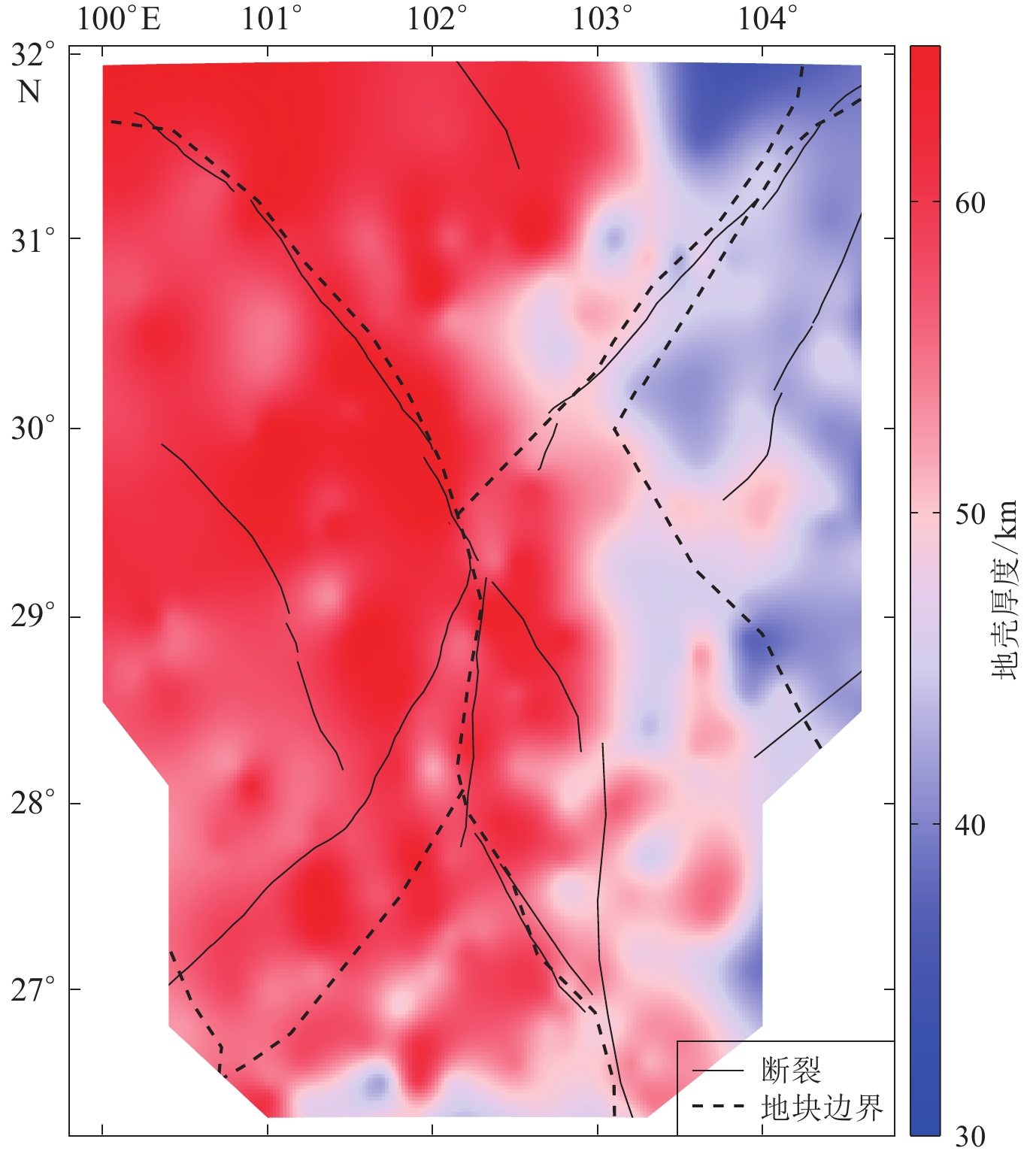Rayleigh wave azimuthal anisotropy in western Sichuan region
-
摘要: 本文使用川西密集地震台阵记录的面波资料,利用程函方程面波成像方法获得了周期为14—60 s的瑞雷波相速度及方位各向异性分布。结果显示:川滇菱形地块的川西北地块内部的低速异常明显,其下地壳各向异性快波方向以NS向为主,松潘—甘孜地块内部的低速异常稍弱,下地壳各向异性快波方向以NW−SESE向为主,表明川西北地块可能存在下地壳通道流,松潘—甘孜地块内部存在的通道流相对较弱;龙门山断裂带和丽江—小金河断裂两侧的速度结构和方位各向异性均有明显差异,可推测青藏高原内部的地壳流在东部和南部分别受高速、高强度的四川盆地和滇中地块阻挡,沿高原边界带发生了侧向流动;周期大于25 s的面波方位各向异性方向为NW−SE;与SKS分裂优势方向相近,说明四川盆地的剪切波各向异性可能主要源于上地幔;而龙门山断裂带附近壳幔各向异性较为复杂,面波方位各向异性与SKS分裂的NW−SE向弱各向异性存在差异,表明该处的剪切波各向异性可能来自地幔更深处,有待进一步研究。Abstract: Based on the observation data of dense seismic array in western Sichuan, we obtain Rayleigh wave phase velocity and azimuthal anisotropy distribution images at 14−60 s period by eikonal surface wave tomography method. The results show that the low velocity of the northwestern block of the Sichuan-Yunnan diamond block is obvious and anisotropic fast wave direction of the lower crust is dominated by NS. The low velocity anomaly inside the Songpan-Garze block is slightly weaker and the anisotropic fast wave direction of the lower crust is dominated by NW-SE, indicating that there may be lower crust channel flow in the northwestern Sichuan-Yunnan diamond block and there is a relatively weak channel flow inside the Songpan-Garze block. The velocity structure and azimuthal anisotropy are significantly different on both sides of the Longmenshan fault zone and the Lijiang-Xiaojinhe fault zone. We speculate that the crustal flow inside the Tibetan Plateau is blocked by two high-velocity and high-intensity blocks in the Sichuan basin and the Central Yunnan block in the east and south, and lateral flows occur along the boundary zone. The azimuthal anisotropy of the surface wave over the period 25 s by NW-SE is similar to that of SKS splitting. It is concluded that the shear wave anisotropy in Sichuan basin may be mainly from the upper mantle. The anisotropy of the crust in the vicinity of the Longmenshan fault zone is complex and the azimuthal anisotropy of the surface wave is different from the weak anisotropy of SKS splitting by NW-SE, indicating that the shear wave anisotropy may be from the deeper mantle and needs further research.
-
引言
印度−欧亚板块的陆−陆碰撞造山运动造就了世界上海拔最高、面积最大的高原—青藏高原,喜马拉雅造山带作为印度板块与欧亚板块相互碰撞的前沿地带,其造山作用一直为地球科学家所关注(Tapponnier et al,1982;Yin,Harrison,2000;许志琴等,2008)。喜马拉雅东构造结处于喜马拉雅造山带东侧(图1),是地壳大规模缩短和构造运动方向发生转变的轴心区域,山脉和水系的走向发生了90°大转弯,地球物理观测结果也显示出相似的剧烈变形,例如GPS测量的地壳运动速度场和上地幔各向异性远震SKS波分裂快波方向都围绕喜马拉雅东构造结发生了顺时针90°旋转(Gan et al,2007;Sol et al,2007;Chang et al,2015)。该地区主要发育有NNE−NE向和WNW−NW向两组活动断裂,例如NNE−NE的米林断裂和墨脱断裂,WNW−NW向的嘉黎断裂和阿帕龙断裂,且地震活动与断裂构造密切相关(邵翠茹等,2008;王晓楠等,2018)。喜马拉雅东构造结的地形变化剧烈,深部结构复杂,强震频发,曾在1950年发生过察隅M8.6大地震,是开展地球动力学研究的天然实验场所。
![]() 图 1 喜马拉雅东构造结区域构造(邓起东等,2002)及台站和2016年近震的分布F1:雅鲁藏布江断裂;F2:墨脱断裂;F3:嘉黎断裂;F4:迫龙—旁辛断裂;F5:阿帕龙断裂;F6:主边界断裂;F7:墨竹工卡断裂;F8:班公错—怒江断裂。左上角为GPS计算的青藏高原地壳运动速度场(Gan et al,2007),其中黑框为研究区Figure 1. The regional geologic setting (Deng et al,2003) and distribution of local earthquakes in 2016 andstations in the eastern Himalayan syntaxisF1:Yarlung Zangbo River fault;F2:Motuo fault;F3:Jiali fault;F4:Polong-Pangxin fault;F5:Apalon fault;F6:Main boundary fault;F7:Mozhugongka fault;F8:Bangongcuo-Nujiang fault. Inset shows the surface velocity field determined from GPS observations in the Tibetan Plateau (Gan et al,2007),and black frame is the studied region
图 1 喜马拉雅东构造结区域构造(邓起东等,2002)及台站和2016年近震的分布F1:雅鲁藏布江断裂;F2:墨脱断裂;F3:嘉黎断裂;F4:迫龙—旁辛断裂;F5:阿帕龙断裂;F6:主边界断裂;F7:墨竹工卡断裂;F8:班公错—怒江断裂。左上角为GPS计算的青藏高原地壳运动速度场(Gan et al,2007),其中黑框为研究区Figure 1. The regional geologic setting (Deng et al,2003) and distribution of local earthquakes in 2016 andstations in the eastern Himalayan syntaxisF1:Yarlung Zangbo River fault;F2:Motuo fault;F3:Jiali fault;F4:Polong-Pangxin fault;F5:Apalon fault;F6:Main boundary fault;F7:Mozhugongka fault;F8:Bangongcuo-Nujiang fault. Inset shows the surface velocity field determined from GPS observations in the Tibetan Plateau (Gan et al,2007),and black frame is the studied region地震波在各向异性介质中传播时,其传播速度和偏振方向及其它特性随波的传播方向的变化而变化,这种现象称为地震各向异性,可以用于探测地壳变形。横波分裂是地震波在各向异性介质中最明显的表现形式,有两个分裂参数,即快波偏振方向和快、慢波的到时延迟,分别反映了介质的变形方向和强度(Silver,1996)。横波分裂被广泛应用于大陆壳幔各向异性变形特征研究中,较深的下地壳和地幔的各向异性被认为是由于矿物晶格优势排列所引起(Mainprice,Nicolas,1989;Silver,1996);浅部上地壳的各向异性一般被认为是由大量微裂隙在应力作用下定向排列而形成(Crampin,Atkinson,1985)。深部各向异性特征分析一般采用远震横波分裂,在喜马拉雅东构造结及周边地区,Sol等(2007)和Chang等(2015)利用远震SKS波分裂开展了上地幔各向异性特征分析,其结果显示快波方向呈现出绕研究区顺时针旋转的特征,Chang等(2015)基于SKS波分裂、GPS和断裂第四纪滑动速率联合分析了岩石圈变形特征,动力学模拟结果显示喜马拉雅东构造结周边地区的岩石圈变形特征为垂直连贯变形模式,即力学上的壳幔耦合模式。浅部上地壳各向异性特征一般采用近震横波分裂,近震横波分裂特征揭示出研究区的断裂构造和应力场控制的微裂隙结构,经常被用来评估区域应力场分布和断裂的活动特性(Boness,Zoback,2006;高原等,2018)。近震横波分裂研究曾在国内多地开展,例如卢龙地区(姚陈等,1992)、唐山地区(高原等,1999)、汶川地震震源区(丁志峰等,2008)和青藏高原东北缘(郭桂红等,2015)等地区。尽管喜马拉雅东构造结地区的地震活动性较强,但是因为近震横波分裂工作需要近震分布区内有台站分布,而研究区野外工作条件恶劣,开展地震观测相对其它地区困难,因此,此项工作一直未开展。本文拟利用2016年雅鲁藏布江下游布设的地震台阵波形记录开展近震横波分裂研究,分析喜马拉雅东构造结上地壳各向异性特征,以期得到该特征与活动断裂和应力场特征的相关性,以及喜马拉雅东构造结与板块碰撞相关的动力学特征。
1. 资料和方法
雅鲁藏布江下游台阵由16个宽频带流动地震台站组成(图1),这些流动地震台站均统一应用REFTEK数据采集器和CMG-3ESP地震计(频带范围为50 Hz−60 s)。台站代码分别是BAX,BEB,DAM,DEX,DOJ,LAD,NYG,QID,SAM,SCY,TOM,WOL,YIG,ZIB,ZOB和ZOS。从图1可以看出,研究所用的地震台站较好地覆盖了地震分布区域,为开展近震横波分裂提供了较为丰富的地震观测资料。本文分析采用记录较为完备的2016年近震波形数据。
在计算地震各向异性参数时,要求地震记录必须清晰记录在横波窗内,横波窗口即S波到达台站时,以sin−1(vP/vS)为顶角的入射角锥形体。在横波入射到地表时,如果入射角大于临界角就会发生全反射现象,造成波形畸变,为避免锥形体内的S波记录被S-P转换波干扰,一般情况下,介质泊松比为0.25时,横波入射角窗口大约为35°。在实际分析中,由于浅部低速层的存在所造成的射线弯曲,可以适度将横波窗的入射角扩至45°—50° (Crampin,Peacock,2005)。因此,此次选取入射角≤45°的波形资料,可使所有波形记录满足窗口要求。
横波分裂参数测量有可视化测量(Chen et al,1987;Peacock et al,1988;Liu et al,1997)和计算机程序自动测定(Shih et al,1989)两种方法。可视化测量方法的步骤为:首先判断选取地震射线能否在横波窗口内截取合适的横波波形;其次,根据质点运动轨迹判定横波是否发生分裂和分析快波偏振方向;最后,测量快、慢波的到时延迟以及检验等工作。该方法每一步均经过人工检测,相较于计算机程序自动测定,该方法更准确可靠,且所提取的地震波形数据更全面,因此本文采用该方法进行测量。
以BAX台记录的一次近震为例(图2),介绍在三分量地震波形记录中进行横波分析分裂的具体过程(丁志峰等,2008;常利军等,2010):
![]() 图 2 BAX台站的一次近震波形记录的横波分裂分析示例(a) 原始横波的三分量波形记录;(b) 图(a)中P波初动窗口放大后的波形记录;(c) 两水平分量的波形记录;(d) 两水平分量的横波质点运动;(e) 旋转到快、慢波方向的水平分量波形;(f) 去除各向异性校正后快、慢波水平分量;(g) 校正后的快、慢波水平分量的质点运动图;(h)用于横波分裂分析的近震震源深度分布Figure 2. An example of shear wave splitting analysis for a recording at station BAX(a) Three-component records of original seismic waveform;(b) Amplified three-component records of P wave in Fig.(a);(c) Two horizontal components of seismograms;(d) Shear wave particle motion in horizontal;(e) Seismograms rotated to the fast and slow shear wave directions;(f) Corrected seismograms in fast-slow coordinate system;(g) Partical motion of the corrected phases;(h) The focal depth distribution of the earthquakes used in shear wave splitting
图 2 BAX台站的一次近震波形记录的横波分裂分析示例(a) 原始横波的三分量波形记录;(b) 图(a)中P波初动窗口放大后的波形记录;(c) 两水平分量的波形记录;(d) 两水平分量的横波质点运动;(e) 旋转到快、慢波方向的水平分量波形;(f) 去除各向异性校正后快、慢波水平分量;(g) 校正后的快、慢波水平分量的质点运动图;(h)用于横波分裂分析的近震震源深度分布Figure 2. An example of shear wave splitting analysis for a recording at station BAX(a) Three-component records of original seismic waveform;(b) Amplified three-component records of P wave in Fig.(a);(c) Two horizontal components of seismograms;(d) Shear wave particle motion in horizontal;(e) Seismograms rotated to the fast and slow shear wave directions;(f) Corrected seismograms in fast-slow coordinate system;(g) Partical motion of the corrected phases;(h) The focal depth distribution of the earthquakes used in shear wave splitting1) 选取清晰可靠的初动信号,测量P波初动的水平(EW和NS)分量和垂直(UD)分量,并计算其入射角和入射方向;同时,要求P波初动的垂直分量应大于水平分量两倍以上,以确保所有地震波都被记录在横波窗内(图2a,b)。
2) 根据两个水平(EW和NS)分量的波形情况选取合适的横波分裂窗口,一般时间间隔在0.3—0.5 s之间,需选取高信噪比地震波形记录,较高的信噪比对后续步骤的顺利进行和结果的准确性影响很大(图2c)。
3) 根据两水平分量的质点运动图是否为椭圆来判断是否存在横波分裂现象。如图2d所示,质点运动图为一个近似椭圆,且从S波初动的质点运动轨迹可以清晰地看出快波偏振方向为近NS方向,慢波方向为与其垂直的近EW方向,依此可判断其为一个合适的近震横波分裂例子;适当旋转角度,可测得快波偏振方向。
4) 将两个水平分量的波形旋转至快、慢波方向(图2e),能够清晰地观察到两个到时不同但波形相似的记录,就此直接测量慢波延迟时间,即快、慢波的到时差,且各向异性校正后的快、慢波分量的到时差消失(图2f),其质点运动轨迹变为近似直线(图2h)。然后根据台站到震源的射线路径距离到时延迟进行归一化处理。
2. 结果
本文对喜马拉雅东构造结区域内16个地震台站的近震波形记录开展横波分裂测量,采用可视化测量方法,从大量的近震横波记录中选取符合横波分裂窗口的记录数据,严格按照上一节所述计算步骤和检验方法,最后得到了这16个台站的横波分裂测量参数,慢波延迟时间要经过归一化处理,在研究区各台站总计得到了369个有效分裂结果。研究区各台站基本参数和横波分裂参数列于表1。图3为研究区各台站快波偏振方向的等面积投影玫瑰图分布。对照表1和图3可以看出,一般在地震密集分布区域内的台站可用于近震横波分裂的有效记录个数较多,比如台站BAX 31个,DAM 12个,DEX 21个,DOJ 54个,LAD 27个,QID 26个,SAM 59个,TOM 27个,ZIB 60个和ZOS 29个等,近震横波分裂的有效个数除了DAM台12个外,其余台站都在20个以上;一般距离地震密集分布区较远的台站可用于近震横波分裂的有效记录个数较少,例如台站BEB 2个,NYG 3个,SCY 7个,WOL 3个,YIG 4个和ZOB 4个等,近震横波分裂有效记录个数都在10个以内。从图3所示的各台站快波偏振优势方向来看,总体上各台站的快波偏振优势方向明显,均呈现了一个主要的优势方向,表1中各台站快波偏振方向的平均值基本上与图3中相应台站的快波偏振优势方向一致,各台站得到的慢波到时延迟平均值为0.99—2.26 ms/km。
表 1 各台站基本参数与横波分裂参数Table 1. Station parameters and results of shear-wave splitting台站代码 东经/° 北纬/° 快波偏振
方向/°快波偏振方向
标准差/°到时延迟
/(ms·km−1)到时延迟标准差
/(ms·km−1)有效记
录条数BAX 95.4 29.6 177 17 2.04 0.65 31 BEB 95.2 29.2 41 4 1.35 0.60 2 DAM 95.5 29.5 165 29 1.83 0.50 12 DEX 95.3 29.3 26 33 1.91 0.92 21 DOJ 94.8 30.0 55 25 1.57 0.68 54 LAD 93.1 29.0 1 12 2.26 0.49 27 NYG 94.2 29.1 60 9 1.07 0.39 3 QID 95.6 30.1 108 9 1.67 0.47 26 SAM 97.0 28.4 165 22 1.87 0.47 59 SCY 96.7 28.8 156 32 0.99 0.25 7 TOM 95.1 30.1 18 13 1.36 0.40 27 WOL 93.7 29.1 96 10 1.48 0.13 3 YIG 94.8 30.2 12 17 1.68 0.66 4 ZIB 94.9 29.6 38 16 0.97 0.28 60 ZOB 96.3 29.6 122 13 2.23 0.46 4 ZOS 93.3 29.8 89 21 1.61 0.32 29 3. 分析和讨论
程成等(2017)和Wang等(2019)利用P波接收函数方法研究了喜马拉雅东构造结的地壳结构,其结果显示地壳厚度从SW向NE方向逐渐增厚的趋势,大约从SW侧的55 km过渡到NE侧的70 km,其中Wang等(2019)综合布格重力异常剖面分析得到上地壳埋深为20—25 km。该区以往地震活动性研究显示地震主要发生在浅部上地壳(杨建亚等,2017;Bai et al,2017;王晓楠等,2018)。如图2h所示,本文用于横波分裂的近震事件震源深度主要分布在8—22 km范围内,因此,本文所得到的近震横波分裂特征主要反映了研究区上地壳各向异性的变形特征。
上地壳介质中广泛分布的微裂隙在应力的作用下会沿一定优势方向排列,这是导致上地壳各向异性的主要原因(Crampin,Atkinson,1985)。通常横波在上地壳各向异性介质中产生的分裂特征可以反映区域应力场特征和活动断裂特征(Crampin,Peacock,2005;高原等,2018)。Boness和Zoback (2006)归纳出上地壳各向异性主要为应力作用和断裂结构所致,即应力和结构控制的各向异性。上地壳近震横波分裂的快波偏振优势方向与微裂隙的定向排列一致,与原地最大主压应力方向一致;靠近或位于活动断裂带上的台站,其快波偏振优势方向通常与活动断裂的走向密切相关,慢波延迟时间对应于上地壳微裂隙在构造应力作用下的几何形态,反映了构造应力的强度和效应,能够较好地反映当前断裂的活动特征(丁志峰等,2008;吴晶等,2009;高原等,2018;Wu et al,2019)。
研究区各台站得到的快波偏振优势方向自西向东,由LAD台的近NS方向到ZOS台和WOL台的近EW方向,再到台站NYG,ZIB,DOJ,BEB和DEX的NE方向,然后是台站YIG,TOM,BAX和DAM的近NS方向或NNE方向,最后到研究区东部台站QID,ZOB,SCY和SAM的NW方向(图3)。大部分位于或靠近活动断裂的台站,其快波偏振优势方向与断裂的走向相一致:位于墨竹工卡断裂上的ZOS台,快波偏振优势方向与近EW的断裂走向一致;位于雅鲁藏布江断裂西段上的WOL台,其快波偏振优势方向与近EW方向的断裂走向一致;位于雅鲁藏布江断裂东段的台站NYG,ZIB和DOJ和墨脱断裂上的台站BEB和DEX的快波偏振优势方向与NE向的断裂走向一致;位于研究区东部NW走向的嘉黎断裂的台站QID,ZOB,SCY和SAM快波偏振优势方向为NW向,与断裂走向一致;位于迫龙—旁辛断裂的台站BAX和DAM的快波偏振优势方向与此断裂的近NS方向的走向一致。距离雅鲁藏布江断裂西段和东段有一定距离的台站LAD和YIG,以及位于雅鲁藏布江断裂东段与嘉黎断裂交会处的TOM台的快波偏振优势方向与该两条断裂走向存在一定角度,但是其与印度板块持续向欧亚板块的推挤作用下在喜马拉雅东构造结及周边地区形成的NNE向主压应力场方向一致(许忠淮,2001),而且也与由GPS和断裂第四纪滑动速率数据分析得到的NNE向压应变方向一致。由以上分析可以看出,喜马拉雅东构造结各台站的快波偏振优势方向基本上可以归纳为受活动断裂控制和应力控制的两组,具体为13个靠近或位于墨竹工卡断裂、雅鲁藏布江断裂、墨脱断裂和嘉黎断裂的台站的上地壳各向异性主要受断裂结构影响,而另外2个距活动断裂有一定距离的台站LAD和YIG,以及处于断裂交会处的TOM台,其上地壳各向异性主要受应力控制。
上地壳近震横波分裂的参数对区域应力场的变化比较敏感,可以通过横波分裂参数随时间的变化特征来分析区域应力场的变化特征(Gao,Crampin,2003)。前人的研究显示,位于地震震源区的台站其近震横波分裂参数在主震前后变化明显,快波偏振方向在主震后一段时间离散度增大,到时延迟在主震后一段时间会增大,随后快波偏振方向和到时延迟会逐渐恢复到正常水平,例如Crampin等(1999)关于冰岛一次M5地震的前震和余震序列的分析显示其横波分裂参数具有随时间变化的规律特征,国内在汶川MS8.0地震和玉树MS7.1地震的震源区横波分裂参数也表现出随时间的变换规律(丁志峰等,2008;常利军等,2010)。为了分析喜马拉雅东构造结横波分裂参数和区域应力场的特征,绘制了2016年各台站横波分裂参数结果随时间的变化图(图4),该图显示快波偏振方向和到时延迟并未表现出随时间的规律变化,整体上比较稳定。根据中国地震台网中心(2016)目录,研究区最大地震为3月21日0点54分发生于工布江达县的ML3.8地震,震中位置为(29.79°N,93.16°E),震源深度为7 km。分析显示,2016年研究区各台站的横波分裂参数未表现出随时间的规律变化特征,主要是由于2016年研究区的地震强度较低,尽管小震定位研究区发生了数百次小震(图1),但未发生过M>5.0较强地震,研究区由小震导致的应力调整还不足以引起横波分裂参数的规律变化。尽管快波偏振方向和到时延迟未表现出随时间的规律变化,而快波偏振优势方向比较突出,但是各台站快波偏振方向和到时延迟时间的离散度还是比较大(图4和表1)。16个台站中,9个台站的快波偏振方向标准差超过15°,15个台站的到时延迟时间标准差超过0.25 ms/km,而且台站间的横波分裂参数变化也较大,快波偏振优势方向有近EW,近NS,NE和NW等各个方向,到时延迟时间的平均值范围为0.99—2.26 ms/km。这也体现了在印度板块持续向欧亚板块碰撞过程中形成的复杂应力场导致了喜马拉雅东构造结复杂的构造和剧烈的变形特征。
4. 结论
本文基于雅鲁藏布江下游台阵16个台站2016年的近震记录,使用可视化横波分裂分析方法计算了各台站横波分裂参数,获得了喜马拉雅东构造结的上地壳各向异性特征。整体上,研究区位于或靠近活动断裂带上的台站,其快波偏振优势方向与断裂的走向基本一致,距离活动断裂有一定距离或位于断裂交会处的台站,其快波偏振优势方向与主压应力场方向一致,反映了结构控制和应力控制作用下的上地壳各向异性特征。研究区各台站之间的横波分裂结果呈现较大差异,自身离散度较大,这些特征反映了东构造结复杂的结构和剧烈的变形。由于研究区2016年的地震活动强度不大,横波分裂参数未表现出随时间的规律变化。此项研究需要对其它震例进一步深入研究,如2017年11月17日的米林MS6.9地震,可能会得到随时间的变化特征。
-
图 1 川西地区构造简图(引自邓起东等,2002)
F1:理塘断裂;F2:鲜水河断裂;F3:大凉山断裂;F4:龙门山断裂带;F5:龙泉山断裂;F6:华蓥山断裂;F7:丽江—小金河断裂;F8:安宁河断裂;F9:小江断裂
Figure 1. Tectonic settings of western Sichuan region (after Deng et al,2002)
F1:Litang fault;F2:Xianshuihe fault;F3:Daliangshan fault;F4:Longmenshan fault zone;F5:Longquanshan fault;F6:Huayingshan fault;F7:Lijiang-Xiaojinhe fault; F8: Anninghe fault;F9:Xiaojiang fault
图 9 研究区地壳厚度分布图(引自Wang et al,2017)
Figure 9. The distributions of the crustal thickness (after Wang et al,2017)
图 11 周期为18 s (a)和50 s (b)的面波方位各向异性与接收函数各向异性和SKS各向异性的对比
图中接收函数各向异性结果来自Zheng等(2018);SKS各项异性结果来自Flesch 等(2005),常利军等(2008)和Wang 等(2008)
Figure 11. Comparison of Rayleigh wave azimuthal anisotropy at 18 s (a) and 50 s (b) periods with receiver function anisotropy and SKS anisotropy
The receiver function anisotropy refers from Zheng et al (2018),and SKS anisotropy are from Flesch et al (2005),Chang et al (2008) and Wang et al (2008)
-
常利军,王椿镛,丁志峰. 2008. 四川及邻区上地幔各向异性研究[J]. 中国科学:D辑,<bold>38</bold>(12):1589–1599. Chang L J,Wang C Y,Ding Z F. 2008. Seismic anisotropy of upper mantle in Sichuan and adjacent regions[J]. <italic>Science in China</italic>:<italic>Series D</italic>,<bold>51</bold>(12):1683–1693.
崔仲雄,裴顺平. 2009. 青藏高原东构造结及周边地区上地幔顶部Pn速度结构和各向异性研究[J]. 地球物理学报,<bold>52</bold>(9):2245–2254. doi: 10.3969/j.issn.0001-5733.2009.09.008 Cui Z X,Pei S P. 2009. Study on Pn velocity and anisotropy in the upper most mantle of the Eastern Himalayan Syntaxis and surrounding regions[J]. <italic>Chinese Journal of Geophysics</italic>,<bold>52</bold>(9):2245–2254 (in Chinese).
邓起东,张培震,冉勇康,杨晓平,闵伟,楚全芝. 2002. 中国活动构造基本特征[J]. 中国科学:D辑,<bold>32</bold>(12):1020–1030. Deng Q D,Zhang P Z,Ran Y K,Yang X P,Min W,Chu Q Z. 2003. Basic characteristics of active tectonics of China[J]. <italic>Science in China</italic>:<italic>Series D</italic>,<bold>46</bold>(4):356–372.
范莉苹,吴建平,房立华,王未来. 2015. 青藏高原东南缘瑞利波群速度分布特征及其构造意义探讨[J]. 地球物理学报,<bold>58</bold>(5):1555–1567. doi: 10.6038/cjg20150509 Fan L P,Wu J P,Fang L H,Wang W L. 2015. The characteristic of Rayleigh wave group velocities in the southeastern margin of the Tibetan Plateau and its tectonic implications[J]. <italic>Chinese Journal of Geophysics</italic>,<bold>58</bold>(5):1555–1567 (in Chinese).
高原,石玉涛,陈安国. 2018. 青藏高原东缘地震各向异性、应力及汶川地震影响[J]. 科学通报,<bold>63</bold>(19):1934–1948. Gao Y,Shi Y T,Chen A G. 2018. Crustal seismic anisotropy and compressive stress in the eastern margin of the Tibetan Plateau and the influence of the <italic>M</italic><sub>S</sub>8.0 Wenchuan earthquake[J]. <italic>Chinese Science Bulletin</italic>,<bold>63</bold>(19):1934–1948 (in Chinese). doi: 10.1360/N972018-00317
刘启元,李昱,陈九辉,郭飚,李顺成,王峻,张绪奇,齐少华. 2009. 汶川<italic>M</italic><sub>S</sub>8.0地震:地壳上地幔S波速度结构的初步研究[J]. 地球物理学报,<bold>52</bold>(2):309–319. Liu Q Y,Li Y,Chen J H,Guo B,Li S C,Wang J,Zhang X Q,Qi S H. 2009. Wenchuan <italic>M</italic><sub>S</sub>8.0 earthquake:Preliminary study of the S wave velocity structure of the crust and upper mantle[J]. <italic>Chinese Journal of Geophysics</italic>,<bold>52</bold>(2):309–319 (in Chinese).
鲁来玉,何正勤,丁志峰,王椿镛. 2014. 基于背景噪声研究云南地区面波速度非均匀性和方位各向异性[J]. 地球物理学报,<bold>57</bold>(3):822–836. doi: 10.6038/cjg20140312 Lu L Y,He Z Q,Ding Z F,Wang C Y. 2014. Azimuth anisotropy and velocity heterogeneity of Yunnan area based on seismic ambient noise[J]. <italic>Chinese Journal of Geophysics</italic>,<bold>57</bold>(3):822–836 (in Chinese).
石玉涛,高原,张永久,王辉,姚志祥. 2013. 松潘—甘孜地块东部、川滇地块北部与四川盆地西部的地壳剪切波分裂[J]. 地球物理学报,<bold>56</bold>(2):481–494. doi: 10.6038/cjg20130212 Shi Y T,Gao Y,Zhang Y J,Wang H,Yao Z X. 2013. Shear wave splitting in the crust in eastern Songpan-Garze block,Sichuan-Yunnan block and western Sichuan basin[J]. <italic>Chinese Journal of Geophysics</italic>,<bold>56</bold>(2):481–494 (in Chinese).
石玉涛,高原,赵翠萍,姚志祥,太龄雪,张永久. 2009. 汶川地震余震序列的地震各向异性[J]. 地球物理学报,<bold>52</bold>(2):398–407. Shi Y T,Gao Y,Zhao C P,Yao Z X,Tai L X,Zhang Y J. 2009. A study of seismic anisotropy of Wenchuan earthquake sequence[J]. <italic>Chinese Journal of Geophysics</italic>,<bold>52</bold>(2):398–407 (in Chinese).
太龄雪,高原,刘庚,肖卓. 2015. 利用中国地震科学台阵研究青藏高原东南缘地壳各向异性:第一期观测资料的剪切波分裂特征[J]. 地球物理学报,<bold>58</bold>(11):4079–4091. Tai L X,Gao Y,Liu G,Xiao Z. 2015. Crustal seismic anisotropy in the southeastern margin of Tibetan Plateau by ChinArray data:Shear-wave splitting from temporary observations of the first phase[J]. <italic>Chinese Journal of Geophysics</italic>,<bold>58</bold>(11):4079–4091 (in Chinese).
王苏,徐晓雅,胡家富. 2015. 青藏高原东南缘的地壳结构与动力学模式研究综述[J]. 地球物理学报,<bold>58</bold>(11):4235–4253. Wang S,Xu X Y,Hu J F. 2015. Review on the study of crustal structure and geodynamic models for the southeast margin of the Tibetan Plateau[J]. <italic>Chinese Journal of Geophysics</italic>,<bold>58</bold>(11):4235–4253 (in Chinese).
吴建平,杨婷,王未来,明跃红,张天中. 2013. 小江断裂带周边地区三维P波速度结构及其构造意义[J]. 地球物理学报,<bold>56</bold>(07):2257–2267. Wu J P,Yang T,Wang W L,Ming Y H,Zhang T Z. 2013. Three dimensional P-wave velocity structure around Xiaojiang fault system and its tectonic implications[J]. <italic>Chinese Journal of Geophysics</italic>,<bold>56</bold>(7):2257–2267 (in Chinese).
熊绍柏,郑晔,尹周勋,曾晓献,全幼黎,孙克忠. 1993. 丽江—攀枝花—者海地带二维地壳结构及其构造意义[J]. 地球物理学报,<bold>36</bold>(04):434–444. doi: 10.3321/j.issn:0001-5733.1993.04.004 Xiong S B,Zheng Y,Yin Z X,Zeng X X,Quan Y L,Sun K Z. 1993. The 2-D structure and its tectonic implication of the crust in the Lijiang-Panzhihua-Zhehai region[J]. <italic>Chinese Journal of Geophysics</italic>,<bold>36</bold>(4):434–444 (in Chinese).
钟世军,吴建平,房立华,王未来,范莉苹,王怀富. 2017. 青藏高原东北缘及周边地区基于程函方程的面波层析成像[J]. 地球物理学报,<bold>60</bold>(6):2304–2314. Zhong S J,Wu J P,Fang L H,Wang W L,Fan L P,Wang H F. 2017. Surface wave eikonal tomography in and around the northeastern margin of the Tibetan Plateau[J]. <italic>Chinese Journal of Geophysics</italic>,<bold>60</bold>(6):2304–2314 (in Chinese).
Chen Y,Zhang Z J,Sun C Q,Badal J. 2013. Crustal anisotropy from Moho converted Ps wave splitting analysis and geodynamic implications beneath the eastern margin of Tibet and surrounding regions[J]. <italic>Gond Res</italic>,<bold>24</bold>(3/4):946–957. doi: 10.1016/j.gr.2012.04.003
Clark M K, Royden L H. 2000. Topographic ooze:Building the eastern margin of Tibet by lower crustal flow[J]. <italic>Geology</italic>,<bold>28</bold>(8):703–706. doi: 10.1130/0091-7613(2000)28<703:TOBTEM>2.0.CO;2
Crampin S. 1981. A review of wave motion in anisotropic and cracked elastic-media[J]. <italic>Wave Motion</italic>,<bold>3</bold>(4):343–391. doi: 10.1016/0165-2125(81)90026-3
England P,Houseman G. 1986. Finite strain calculations of continental deformation:Comparison with the India-Asia collision zone[J]. <italic>J Geophys Res Atmos</italic>,<bold>91</bold>(B3):3664–3676.
Flesch L M,Holt W E,Silver P G,Stephenson M,Wang C Y,Chan W W. 2005. Constraining the extent of crust-mantle coupling in Central Asia using GPS,geologic,and shear wave splitting data[J]. <italic>Earth Planet Sci Lett</italic>,<bold>238</bold>(1/2):248–268.
Gee L S,Jordan T H. 1992. Generalized seismological data functionals[J]. <italic>Geophys J Int</italic>,<bold>111</bold>(2):363–390. doi: 10.1111/j.1365-246X.1992.tb00584.x
Jin G,Gaherty J B. 2015. Surface wave phase-velocity tomography based on multichannel cross-correlation[J]. <italic>Geophys J Int</italic>,<bold>201</bold>(3):1383–1398. doi: 10.1093/gji/ggv079
Ko B,Jung H. 2015. Crystal preferred orientation of an amphibole experimentally deformed by simple shear[J]. <italic>Nat Commun</italic>,<bold>6</bold>:6586. doi: 10.1038/ncomms7586
Li C X,He D F,Sun Y P,He J Y,Jiang Z X. 2015. Structural characteristic and origin of intra-continental fold belt in the eastern Sichuan basin,South China block[J]. <italic>Asian Earth Sci</italic>,<bold>111</bold>:206–221. doi: 10.1016/j.jseaes.2015.07.027
Lin F C,Ritzwoller M H,Snieder R. 2009. Eikonal tomography:Surface wave tomography by phase front tracking across a regional broad-band seismic array[J]. <italic>Geophys J Int</italic>,<bold>177</bold>(3):1091–1110. doi: 10.1111/j.1365-246X.2009.04105.x
Lin F C,Ritzwoller M H. 2011. Helmholtz surface wave tomography for isotropic and azimuthally anisotropic structure[J]. <italic>Geophys J Int</italic>,<bold>186</bold>(3):1104–1120. doi: 10.1111/j.1365-246X.2011.05070.x
Liu Q Y,van der Hilst R D,Li Y,Yao H J,Chen J H,Guo B,Qi S H,Wang J,Huang H,Li S C. 2014. Eastward expansion of the Tibetan Plateau by crustal flow and strain partitioning across faults[J]. <italic>Nature Geoscience</italic>,<bold>7</bold>(5):361–365. doi: 10.1038/ngeo2130
Montagner J P,Griot-Pommera D,Lavé J. 2000. How to relate body wave and surface wave anisotropy?[J]. <italic>J Geophys Res</italic>:<italic>Solid Earth</italic>,<bold>105</bold>(B8):19015–19027. doi: 10.1029/2000JB900015
Royden L H,Burchfiel B C,King R W,Wang E,Chen Z L,Shen F,Liu Y P. 1997. Surface deformation and lower crustal flow in eastern Tibet[J]. <italic>Science</italic>,<bold>276</bold>(5313):788–790. doi: 10.1126/science.276.5313.788
Royden L H,Burchfiel B C,van der Hilst R D. 2008. The geological evolution of the Tibetan Plateau[J]. <italic>Science</italic>,<bold>321</bold>(5892):1054–1058. doi: 10.1126/science.1155371
Smith M L,Dahlen F A. 1973. The azimuthal dependence of Love and Rayleigh wave propagation in a slightly anisotropic medium[J]. <italic>J Geophys Res</italic>:<italic>Solid Earth</italic>,<bold>78</bold>(17):3321–3333. doi: 10.1029/JB078i017p03321
Tapponnier P,Molnar P. 1976. Slip-line field theory and large-scale continental tectonics[J]. <italic>Nature</italic>,<bold>264</bold>(5584):319–324. doi: 10.1038/264319a0
Wang C Y,Flesch L M,Silver P G,Chang L J,Chan W W. 2008. Evidence for mechanically coupled lithosphere in central Asia and resulting implications[J]. <italic>Geology</italic>,<bold>36</bold>(5):363–366. doi: 10.1130/G24450A.1
Wang C Y,Zhu L P,Lou H,Huang B S,Yao Z X,Luo X H. 2010. Crustal thicknesses and Poisson’s ratios in the eastern Tibetan Plateau and their tectonic implications[J]. <italic>J Geophys Res</italic>:<italic>Solid Earth</italic>,<bold>115</bold>(B11):B11301. doi: 10.1029/2010JB007527
Wang W L,Wu J P,Fang L H,Lai G J,Yang T,Cai Y. 2014. S wave velocity structure in southwest China from surface wave tomography and receiver functions[J]. <italic>J Geophys Res</italic>:<italic>Solid Earth</italic>,<bold>119</bold>(2):1061–1078. doi: 10.1002/2013JB010317
Wang W L,Wu J P,Fang L H,Lai G,Cai Y. 2017. Crustal thickness and Poisson’s ratio in southwest China based on data from dense seismic arrays[J]. <italic>J Geophys Res</italic>:<italic>Solid Earth</italic>,<bold>122</bold>(9):7219–7235. doi: 10.1002/2017JB013978
Xiong X S,Gao R,Wang H Y,Zhang J S,Guo L H,Yang T,Cai Y. 2016. Frozen subduction in the Yangtze block:Insights from the deep seismic profiling and gravity anomaly in east Sichuan fold belt[J]. <italic>Earthquake Science</italic>,<bold>29</bold>(2):61–70. doi: 10.1007/s11589-016-0140-9
Zheng T,Ding Z F,Ning J Y,Chang L J,Wang X C,Kong F S,Liu Kelly H,Gao Stephen S. 2018. Crustal azimuthal anisotropy beneath the southeastern Tibetan Plateau and its geodynamic implications[J]. <italic>J Geophys Res</italic>:<italic>Solid Earth</italic>,<bold>123</bold>(11):9733–9749. doi: 10.1029/2018JB015995
-
期刊类型引用(1)
1. 刘嘉栋,吴庆举,强正阳,朱敏. 利用接收函数研究四川威远地区地壳结构特征. 地球物理学报. 2024(07): 2637-2653 .  百度学术
百度学术
其他类型引用(0)





 下载:
下载:
















